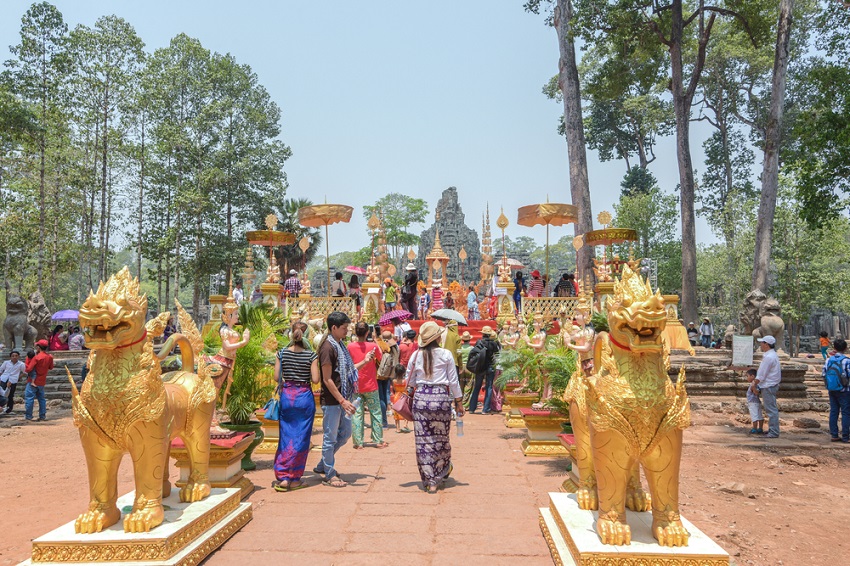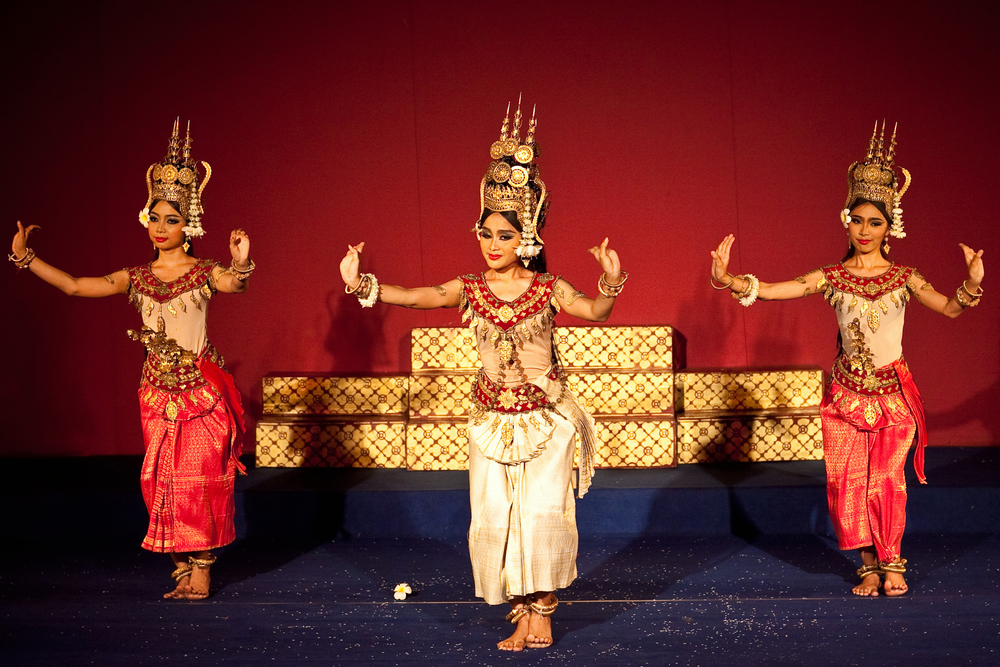Cambodia - ritual and festival
Traditions and ceremonies are what reflect ways of life, ideas and beliefs of people in that country. Cambodian traditions and ceremonies are no exception either. Even though this land was badly destroyed by the Khmer Rouge, the traditions, ceremonies and other festivals such as Ploughing Ceremony, Songkran Festival and Water Festival have endured a test of time. These are very popular among Cambodian people and cover different periods of time. The longest ceremony taking 15 days is Sandonta Ceremony that combines a belief in ancestor spirits with Buddhism.
The following ceremonies mentioned beloware all taken from A Book of Royal Ceremonies of Twelve Months starting with the Songkran Festival held in the Fifth Lunar Month or Chet Month, which is April. The Ploughing Ceremony is held in the Sixth Lunar Month or Pisakh Month, which is May. Sandonta Ceremony appeared in Royal Ceremonies of Twelve Months by the name of the Tenth Lunar Month Festival which is set to be held later in the Tenth Lunar Month or Bhatarabot Month, which is October. The Water Festival is held in the Twelve Lunar Month or Kattik Month, which is November. Brief information of each ceremony is discussed in the next section.
Songkran Festival: Cambodian New Year
Songkran Festival or Bon Chol Chanum Tamoi in Cambodian means New Year Festival appeared in Royal Ceremonies of Twelve Months as it is crucial to all Cambodian. According to its oral history similar to what has been told in Thailand, it is a Buddhist contest in which Dhammabal Kumar challenged Sri Kabil Brahma. Cambodian Songkran Festival takes 3 days. The first day is Maha Songkran or Ta-ngai Maha Songkran in Cambodian. The second day is literally the middle day or Ta-ngai Gon Dal, and finally the third day is Ta-ngai Learng Sok or the day that marks the new year. Yet, in some years, the festival can take 4 days due to the orbit of the moon when the middle day is doubled (ไทยรัฐออนไลน์, 2559).
Cambodian Songkran Festival is akin to Thai’s since it was originally a new year shared in this region. It is truly a family time as all family members come back home and spend some time together. Before the festival, the family members help each other clean their house and decorate it with colorful lanterns. They prepare new clothes for this coming festival yet most importantly arrange the offerings to angels (สงกรานต์กัมพูชา วันปีใหม่แบบเขมร, 2559).
On the first day of Songkran or Ta-ngai Maha Songkran Day, it is very common to see this important ceremony taking place. Welcome New Angel Ceremony is set off at the same time across the country acknowledging the people through televise programs, radio andbell ringing sound from a temple nearby village. It is read as a signal indicating the new angel has reached the earth to accept his offerings with a promise to stay on earth for a year so that he can fulfil his duty of the land protector. The welcome ceremony begins with lighting incense sticks and a candle to assume an act of paying respect to Triple Gem followed by sprinkling scented water on the offerings and making a wish afterwards. Later, people offer food to the monks at a temple as well as keeping a tradition of bringing grains of sand into the temple to build a sand pagoda out of it. On the second day or Ta-ngai Gon Dal, it is the day of the dead, passed away ancestors including fathers and mothers. In the morning, they dress up in new clothes and arrange food and deserts to offer to their parents and patrons. After a short while, they go to the temple and offer food to the monks while ensuring the continuity of sand tradition that they will build another sand pagoda. On the last day or Ta-ngai Learng Sok, it marks the new year for Cambodian. In the morning, people go to the temple, offer food to the monks and sprinkle water onto a Buddha image. In the afternoon, they have a family ritual called Water Blessing in which younger family members pour water on the hands of the elders and ask for a blessing. Afterwards, it is a joyful time for the young to throw water at each other. In addition to water throwing, folk games such as Saba, hiding a cloth behind one’s back and Tug of war have also been put into play since the first day of Songkran or Ta-ngai Maha Songkran (สงกรานต์กัมพูชา วันปีใหม่แบบเขมร, 2559).
Cambodian Songkran is still seen these days. It is assumed a prohibition during three days of Songkran for the Cambodians to work or get engaged in any irrelevant activities. This prohibition has been kept a tradition until now.
Ploughing Ceremony: Cambodian agriculturalists’ morale
Like in Thailand, CambodianPloughing Ceremony is held in May. Its presumed existence was as late as in Angkor Thom period. The ancient monarchs saw it asanimportant ceremony to the way of life of those who worked in agriculture. Even though the monarchs were never agriculturalists given the fact that they had been born entitled to royal demesne, they did not consider keeping pieces of land private. On the contrary, the monarchs gave those to their subjects. Hence, to express loyalty and gratitude towards monarch’s benevolence, the subjects dedicated their agricultural products to the monarchs. It was ‘paying tribute’(ออกญาเทพพิทู และ ขุนอุดมปรีชา, 2550: 87).
While the monarchs, who were never the agriculturalists themselves, took tribute paid by their subjects, they never failed to show supports for the subjects. This good intention was conveyed through Ploughing Ceremony giving a strong faith that this ceremony would bring healthiness to all the subjects.
This was how the ceremonywas initiated and passed on for many generations. Just like any other countries in the world, at some point Cambodia had turbulent times when it was uncertain whether this ceremony could be performed.However, according to one of Mom Rajawongse BenjapaKrai-riksh’s journals, Nao Khmer or Life in Khmer 2, it described ‘when Cambodia fell under communism, nobody knew exactly where groups of Brahmans had escaped. But when Narodom Sihanouk was made king again in 1993, those Brahmans started to appear.’ (เบญจาภา ไกรฤกษ์, 2540:42).Noticeably, Cambodia under communist rule, led by Khmer Rougeduring 1975-1979, lacked political stabilities and divided Cambodia into 3 parties. It was not until 1992 when the regained Ploughing Ceremony came into sight because the Brahmans were the ones responsible for the ceremony performance.
After Narodom Sihanouk reclaimed the throne in 1993, the ceremony was revived in 1994 and has been conducted until now. The old ceremonial placeswere the Palace and the King Crematorium Field in Phnom Penh.In 2013,the ceremonial places was changed to Kampong Cham Province marking the very first time the ceremony was taking place out of Phnom Penh. From 2015-16, it was held in Battambong Province and Siem Reap Province respectively. It was another opportunity given to hold the ceremony out of the capital city. There has been no clear explanation as to who chose the ceremonial place and why so. Nonetheless, King Narodom Sihamoni has been present as the president of the ceremony every year.
In terms of conducting the ceremony, Cambodia shares some similarities with Thailand, yet is different in details. For example, a person responsible for taking a role of the Brahmin master of the ceremony in Thailand is the Permanent Secretary for Ministry of Agriculture and Cooperatives; meanwhile, in Cambodia this role is reserved for the Prime Minister. The Brahmin master of the ceremony,who is a leader assigning the performance, is a term used in Thailand, but Cambodia refers to Naga.The journey of Naga to the ceremonial pavilion requires a litter with 12 entourages holding royal regalia, followed by the Queen Naga entourage (เบญจาภา ไกรฤกษ์, 2540:42). Unlike in Thailand, the Brahmin master of the ceremony joins the procession with his two Devi, each of whom is bearing golden and silver rice containers. However, the main purpose of conducting this ceremony in both Thailand and Cambodia is to lift morale among the agriculturalists.
What seems outstanding in this ceremony is how the sacred oxen make an agricultural prediction by choosing to eat seven kinds of offered food that is rice, corn, green beans, fresh grass, sesame, water and rice whisky. If the sacred oxen choose to eat which of those kinds, it simply implies that kind of food will be plenty. In 2016’s Cambodian Ploughing Ceremony, the sacred oxen chose to eat rice, corn and green beans making a prediction these three kinds of food would be plenty.
Sandonta Ceremony: big merit-making event of the Cambodians
Sandonta or Bonchumben is a big merit-making event of the Cambodians. Sandonta is rooted from Cambodian Language. San means making offerings, and Donta means ancestors. Therefore, this ceremony is dedicated to passed away ancestors.It takes 15 days starting from the first waning moon night to the 15th waning moon night in the Tenth Lunar Month. The first phase is called Bentooj or a small celebration while the next phase is called Benthom or a big celebration. What to be done on Bentooj is to go to the temple and offer food to the monks, but what is more important is taking place on Benthom. It is a family time when every member comes back home and stays together to do good deeds dedicated to their passed ancestors. Each of the members take turns at offering food to the monks at the temple during these 14 days, all of which are waning moon nights believed that the ancestor spirits come back on earth again. Thus, Kan Song ritual is practices for this specific purpose.
This ceremony originated from a belief that those ancestor spirits that come back on earth stay at the temple in their hometown while they are waiting for their children and grandchildren to make merit here. Thereby, it is necessary for the Cambodians to make merit in Sandonta Ceremony their hometown temples. If they go somewhere else, the ancestor spirits waiting at the hometown temples will not be able to meet their offspring. The spirits will search for every temple. If they do not find them, they will get angry and put a curse on the children and grandchildren.
On the other hand, if their children and grandchildren come back home and make merit at hometown temple, the ancestor spirits will be so pleased. They will give blessings and protect them. This ritual indicates a mixture of beliefs combining the belief in ancestor spirits or in spirits with an article of faith in Buddhism suggesting any temple is a temporary stay for those spirits who come back on earth. Offering food to monks, thus, is giving food to the mediums who will later spiritually feed the spirits. In this case, the monks and temples function as a medium sending communication between the ancestor spirits and their children in the ritual.
Making merit in Sandonta Ceremony requires two main dishes, On-som and By Ben. On-som is sticky rice stuffed with pork or banana while By Ben is rice balls cooked to give away to irrelevant spirits. Considering the belief of Cambodians living in Surin province of Thailand, By Ben can be assumed to be associated with Buddhism. The amount of rice balls used in the ritual is a total of 49 balls, which is the same amount that Buddha took from Visakha. So, the number has been used as a reference by the Cambodians in Surin province (ศิริพร สุเมธารัตน์, 2553:455).
When the merit making has been carried out until 14th or the 14th waning moon night of the tenth month, there is a celebration called ‘Kansong’ to be held along with a prayer of Bahu Deva marking the end of this ritual. It is also Benthom Day, the most important day in this ceremony, as the children and grandchildren come and gather at their houses. Food and deserts are well-prepared for the merit making at the temples and offering to ancestor spirits at their houses. The leading performer in the ritual is the grandmaster. As the ritual begins, the children, grandchildren and other participants utter ‘Mouay Donta, Mouay Donta, Mouay Donta’ (ไกรศักดิ์ ศรีพนม, 2554: 112) to invite the ancestor spirits for food offering.This timerepresents holy presence of this practice, and shows a unified spirit of the offspring conducting this ceremony to express their gratitude towards the passed away ancestors. However, it is noticeable that no monks engaged in this ritual. The practice takes place at home with only the grandmaster and participants.
On the next day or the 15th waning moon night of the Tenth Lunar Month, it is the last day of the ceremony. The ancestor spirits are to be sent back to underworld. The merit making in the morning takes place at the temple and the afternoon is the time when their children and grandchildren prepare for the ancestor spirits’ departure. They make an intricate work in a form of small-sized boat out of leaf sheath of banana tree and coir. These tree-made boats are to be used as food and desert containers taken to release into river for that they will guide the ancestor spirits back to underworld. This is how the 15-day Sandonta Ceremony held by the unified spirit of the offspring and participants ends (ไกรศักดิ์ ศรีพนม, 2554: 113).
In conclusion, Sandonta Ceremony is a big merit making event of the Cambodians suggesting the mixture of beliefs blending a practice of the belief in ancestor spirits and Buddhism, in which the ritual is performed to express gratitude towards the ancestors. It also helps enhancing family relationships given the fact that the family members come back home at least once a year for this ceremony.
Though the world is changing so drastically, the Sandonta Ceremony or Bonchumben of the Cambodians has endured the course of time and maintained its practice until these days. The reason might be the fear of the ancestor spirits’ curses putting on the offspring in case they ignore the ceremony. Another plausible reason might be that it is the time when all the family members are present making merit and enjoying meals altogether. The time is so precious that nobody can ignore it.
Bom Om Tuk: Water Festival of the Cambodians
Water Festival or Bon Om Tuk is the most anticipated joyful festival of the Cambodians. The government announces three national holidays from the 14th and 15th waxing moon nights to the first waning moon night of Twelfth Lunar Month each year. The celebrations take places all over Cambodia. However, the biggest celebration is held in Phnom Penh by Chatumook River, where the three main rivers in Cambodia, Mekong River, Bassac River and Sap River join. Narodom Sihamoni, the King of Cambodia, attends the ceremony as its president along with the government, other high-ranking officials and the people of Cambodia (ธีรภาพ โลหิตกุล, 2558:152).
Bon Om Tuk Festival is held to worship and express gratitude towards the rivers that bring plenteousness to life. It is an ancient royal tradition appeared in A Book of Royal Ceremonies of the Twelve Months by Kun Udompreecha detailing the twelfth month ceremonies include Royal Barge, Royal Krathong and Wai Phra Kae, a practice of worshipping the moon (ออกญาเทพพิทู และ ขุนอุดมปรีชา, 2550: 22). These ceremonies have traditional association with Bon Om Tuk Festival as it features similar main ceremonies. The first one is Royal Krathong taking place at nightwhen it is released into the river.
In addition to Royal Krathong releasing, there is also Boat Procession Contest in which participating convoys of boats are beautifully decorated with colorful lights compete in the contest. Second, the ceremony of worshipping the moon or Sompreah Phra Kae in Cambodian is held to pray for plentiful food supplies. Lastly, Ou Ommok Ceremony requires people to come and gather at the temple at midnight. Then, they will have Ommok, a kind of food that somewhat resembles pounded unripe rice mixed with banana and shredded coconut (ธีรภาพ โลหิตกุล, 2558:153).
Despite the most anticipated festival,it was skipped for these following reasons. In 2010, a bridge connecting between Koh Pich and Phnom Penh was broken down ending in unforgettable tragedy. Floods in Cambodia in 2011 prevented it, and Narodom Sihanouk’s death in 2012 made it an unlikely situation for the government to host the festival. So, it was inevitable to skip Bon Om Tuk three years in a row. It was not until 2014 when the Water Festival was revived with KingNarodom Sihamoni presiding over.The festival had so much joyous air. It hosted concerts, Boat Procession Contest as well as Long Boat Competition. However, in 2015, the government decided to cancel the festival because the water level of Tonle Sap was decreasing to the point where it was impossible to host any kind of boat competitions. People just viewed it differently. They believed it was the government’s intention to avoid crowds of people gathering about one place at a time of intense politics in the country. However, government officials and labors working in textile industry still took three-day holiday according to the government’s announcement
Conclusion
The traditions and ceremonies mentioned above convey the Cambodians’ ways of life ranging from the past to the present. Unfortunately, much of the traditions and ceremonies’ development details appeared onA Book of Royal Ceremonies of Twelve Months cannot be fully explained in this report.These royal ancient traditions are supposed to be practiced within court or both within and without court, but, sadly, no further details are provided. Even so, these traditions and ceremonies are still present.Some might have been skipped by the government, but it is not as important as the fact that the traditions and ceremonies related to the people’s ways of life still have strong awareness amongst the people. In hopes of changes in Cambodia’ economics, politics and society, these traditions and ceremonies need to reaffirm their long-lasting existences. They should not only be living in long distant memories filled with joyfulness but never really happened.
Bibliography
เบญจาภา ไกรฤกษ์. (29 กรกฎาคม 2540). เนาขแมร์อยู่เขมรภาค 2. มติชนสุดสัปดาห์, 17(884), 42-43.
ไกรศักดิ์ ศรีพนม. (ตุลาคม 2554). 'จุมเบ็ณฑ์ - แซนโฎนตา' เทศกาลไหว้ผีบรรพชนคนเขมร. เมืองโบราณ, 37(3), 104-113.
ธีรภาพ โลหิตกุล. (ตุลาคม 2558). "บอน อม ตุก" - บุญบูชามหานที. ทางอีศาน, 4(42), 152-155.
ศิริพร สุเมธารัตน์. (2553). ประวัติศาสตร์ท้องถิ่นเมืองสุรินทร์. สุรินทร์: โรงพิมพ์ ส.พันธุ์เพ็ญ.
สงกรานต์กัมพูชา วันปีใหม่แบบเขมร. (15 เมษายน 2559). เรียกใช้เมื่อ 26 กันยายน 2559 จาก เว็บไซต์ไทยรัฐออนไลน์: http://www.thairath.co.th/content/605709
ออกญาเทพพิทู และ ขุนอุดมปรีชา. (2550). พระราชพิธีทวาทศมาส หรือพระราชพิธีสิบสองเดือนกรุงกัมพูชา ภาค 2. (ศานติ ภักดีคา, ผู้แปล) กรุงเทพมหานคร: อมรินทร์พริ้นติ้งแอนด์พับลิชชิ่ง.
ออกญาเทพพิทู และ ขุนอุดมปรีชา. (2550). พระราชพิธีทวาทศมาส หรือพระราชพิธีสิบสองเดือนกรุงกัมพูชา ภาค 3. (ศานติ ภักดีคา, ผู้แปล) กรุงเทพมหานคร: อมรินทร์พริ้นติ้งแอนด์พับลิชชิ่ง.





